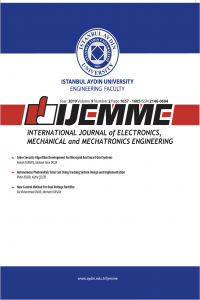Implementation and Evaluation of Maximum Power Point Tracking (MPPT) Based on Adaptive Neuro-Fuzzy Inference System for Photovoltaic PV System
Implementation and Evaluation of Maximum Power Point Tracking (MPPT) Based on Adaptive Neuro-Fuzzy Inference System for Photovoltaic PV System
The conversion of energy of sunlight into electricity is done using photovoltaic (PV) cells. This paper introduces, comparing, analyzing and evaluating the performance of the PV systems which are operating with MPPTs that work by adaptive neuro fuzzy interference system (ANFIS) technique with other MPPT algorithms such as Perturb and Observe (P&O) algorithm, Fuzzy Logic Control (FLC) algorithm and Artificial Neural Network (ANN) algorithm. These algorithms work to control the duty cycle (D) of the pulse signal that goes to the switch of the DC-DC converter for maximizing the power generated by the solar panel. The paper also introduces simulating and modeling a general PV panel with some adjustable parameters for modelling any real PV model using its electrical data sheet. In addition, the work tests the model for the influence of changing in operation solar irradiation and operation temperature on I-V and P-V curves. MPPT algorithms are implemented using boost DC-DC converter with constant resistive load. All systems are analyzed and simulated by using MATLAB-Simulink program. Simulation results show that the ANFIS and ANN based MPPT method gives faster response to archive the MPP and is more efficient than FLC MPPT and the P&O MPPT methods.
Keywords:
Photovoltaic cell, maximum power point tracking, fuzzy logic control artificial neural network, adaptive neuro-fuzzy inference system,
___
- Foster, Robert, Majid Ghassemi, and Alma Cota. Solar energy: renewable energy and the environment. CRC Press, 2009.
- Pelc, Robin, and Rod M. Fujita. "Renewable energy from the ocean." Marine Policy 26.6 (2002): [471-479].
- Khaligh, A., and O. C. Onar. "Energy harvesting: solar, wind, and ocean energy conversion systems 2009."
- Luque, Antonio, and Steven Hegedus, eds. Handbook of photovoltaic science and engineering. John Wiley & Sons, 2011.
- Aribisala, Henry A. "Improving the efficiency of solar photovoltaic power system." (2013). http://digitalcommons.uri.edu/theses/161.
- Esram, Trishan, and Patrick L. Chapman. "Comparison of photovoltaic array maximum power point tracking techniques." IEEE Transactions on energy conversion 22.2 (2007): [439-449].
- Faranda, Roberto, and Sonia Leva. "Energy comparison of MPPT techniques for PV Systems." WSEAS transactions on power systems 3.6 (2008): [446-455].
- Mukund R. Patel, Design, Analysis, and Operation Wind and Solar Power Systems, Publishedin 2006 by CRC Press Taylor & Francis Group, Boca Raton, FL [33487-2742].
- Goetzberger, Adolf, and Volker Uwe Hoffmann. Photovoltaic solar energy generation. Vol. 112. Springer Science & Business Media, 2005.
- Hasan Mahamudul, Mekhilef Saad, and Metselaar Ibrahim Henk. "Photovoltaic System Modeling with Fuzzy Logic Based Maximum Power Point Tracking Algorithm." International Journal of Photo energy 2013.
- Faranda, Roberto, and Sonia Leva. "Energy comparison of MPPT techniques for PV Systems." WSEAS transactions on power systems 3.6 (2008): [446-455].
- Sadek, Sahar M., et al. "Fuzzy P & O Maximum Power Point Tracking Algorithm for a Stand Alone Photovoltaic System Feeding Hybrid Loads." Smart Grid and Renewable Energy 5.02 (2014): 19.
- Zainudin, Hairul Nissah, and Saad Mekhilef. "Comparison study of maximum power point tracker techniques for PV systems." (2010).
- Dolara, A., R. Faranda, and S. Leva. "Energy comparison of seven MPPT techniques for PV systems." Journal of Electromagnetic Analysis and Applications (2009).
- Saleh Elkelani Babaa, Matthew Armstrong, Volker Pickertm "Overview of Maximum Power Point Tracking Control Methods for PV Systems" Journal of Power and Energy Engineering, [2014, 2, 59-72]
- Sivagamasundari, M. S., P. Melba Mary, and V. K. Velvizhi. "Maximum power point tracking for photovoltaic system by perturb and observe method using buck boost converter." International Journal of Advanced Research in Electrical, Electronics and Instrumentation Engineering 2.6 (2013): [2433-2439].
- Bendib, Boualem, Hocine Belmili, and Fateh Krim. "A survey of the most used MPPT methods: Conventional and advanced algorithms applied for photovoltaic systems." Renewable and Sustainable Energy Reviews 45 (2015): [637-648].
- Yang, Shih-Ming, Y. J. Tung, and Y. C. Liu. "A NEURO‐FUZZY SYSTEM DESIGN METHODOLOGY FOR VIBRATION CONTROL." Asian Journal of control 7.4 (2005): [393-400].
- Ahmed, Jubaer, and Zainal Salam. "A Modified P&O Maximum Power Point Tracking Method with Reduced Steady-State Oscillation and Improved Tracking Efficiency." IEEE Transactions on Sustainable Energy 7.4 (2016): 1506-1515.
- Femia, Nicola, et al. "Optimization of perturb and observe maximum power point tracking method." IEEE transactions on Power Electronics 20.4 (2005): [963-973].
- Zainuri, Muhammad Ammirrul Atiqi Mohd, et al. "Development of adaptive perturb and observe-fuzzy control maximum power point tracking for photovoltaic boost dc–dc converter." IET Renewable Power Generation 8.2 (2013): [183-194].
- David Sanz Morales, "Maximum Power Point Tracking Algorithms for Photovoltaic Applications", Faculty of Electronics, Communications and Automation. Espoo 14.12.2010.
- Harjai, Arjav, Abhishek Bhardwaj, and Mrutyunjaya Sandhibigraha. Study of maximum power point tracking (MPPT) techniques in a solar photovoltaic array. Diss. 2011.
- ISSN: 2146-0604
- Başlangıç: 2011
- Yayıncı: İstanbul Aydın Üniversitesi
